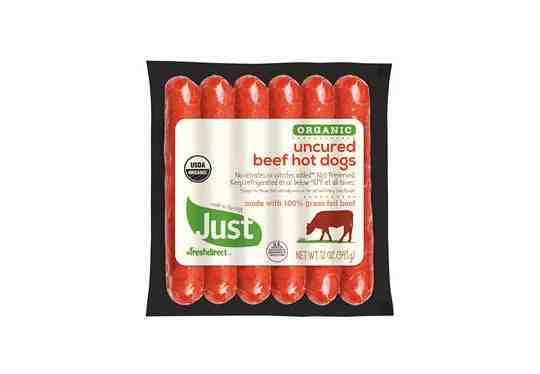Clear Food, an independent company that analyzes food at the molecular level, found that 14.4% of the sausages it tested were “problematic.” Clear Food reported that it found human DNA in six of 345 samples, or 2 percent of all samples tested.
What parts of the animal are in hot dogs?

According to the Food and Agriculture Organization of the United Nations (FAO): “Meat raw materials used for precooked-cooked products are lower-grade muscle trimmings, fat tissues, head meat, animal feet, animals, blood, liver and other edible by-products of slaughter”. This may interest you : Are hot dogs made of pig intestines?.
What part of the pork is in a hot dog? Most of the time, hot dogs are made with skeleton meat, which is cuts of the same type of meat used for ground beef, steaks, and roasts. The trimmings grind very well, which is what gives them that homogeneous texture. Salt is added to the meat, which gives the mixture a sticky texture.
What parts of beef are in hot dogs?
Beef trimmings are the excess beef that is made when meat producers create cuts of beef such as steak, ribs, or brisket. These ornaments are still of high quality, but are not sold in this condition because the pieces are too small and not uniform in size. To see also : Are there rats in hot dogs?. These pieces are used to make hot dogs.
What beef parts go into a hot dog?
“The raw meat materials used for precooked-cooked products are lower-grade muscle trimmings, fat tissues, head meat, animal feet, animal skin, blood, liver, and other edible by-products of slaughter.”
What meat is actually in a hot dog?
Pork and beef are the traditional meats used in hot dogs. Less expensive hot dogs are often made with chicken or turkey, using inexpensive mechanically separated poultry.
Is there organ meat in hot dogs?
Assorted meats or organ meats are not typically used in hot dogs or sausages and, if organs are used, the specific organ will be listed in the ingredient statement on the package and the front of the package will state “with assorted meats” or “with meat by-products†.
Is there human meat in hot dogs?
The Clear Labs hot dog study found human DNA samples in 2 percent of 345 hot dogs and sausages. Two-thirds of that human DNA was found in vegetarian sausages.
Is organ meat used in hot dogs?
Other gross things in hot dogs include: Natural sheep casing made from lamb intestines. Variety of meats: internal organs (such as liver or tongue) other than muscle. Meat trimmings: a main ingredient that may contain organ meat, or chicken or turkey meat removed from the bone by mechanical force.
What meat is actually in a hot dog?
Pork and beef are the traditional meats used in hot dogs. Less expensive hot dogs are often made with chicken or turkey, using inexpensive mechanically separated poultry.
What kind of meat is in hot dogs?
What are hotdogs made of? Hot dogs are made from emulsified chicken, beef, or pork trimmings. This meat mixture is mixed with other ingredients (such as preservatives, spices, and dyes) into a dough-like substance.
Is there horse meat in hot dogs?

Some products, instead of being 100% beef, were 100% horse meat. That same year, it was revealed that lamb sold in Chinese restaurants might actually be rat meat mixed with gelatin and food coloring.
Are hot dogs made with horse meat? Hot dogs are made from animal parts, but they are not leftovers. It’s the same stuff you’d turn into ground beef or ground pork. Garnishes used to make hot dogs are pieces of meat that don’t work for steaks and roasts because they don’t have a certain tenderness, size, shape, or weight.”
Is horse a hot dog?
It’s another case of horse meat being found in products that shouldn’t contain it. Furniture giant Ikea said on Thursday it had withdrawn hot dogs from its stores in Russia after tests revealed they contained horse meat.
What is horse meat called?
Horse meat, or chevaline, as its supporters have renamed it, resembles beef, but darker, with a coarser grain and yellow fat. It seems healthy enough, with almost as much omega-3 fatty acids as farmed salmon and twice the iron as steak.
What does horse taste like?
Horse meat is widely reported to be somewhat sweet, a bit spicy, and a cross between beef and venison, according to the International Business Times. While the meat of younger horses tends to be slightly pinkish in color, older horses have darker reddish-colored meat.
Is there horse meat in dog food?
In the 1920s, according to Nestlé, slaughterhouses opened pet food companies to dispose of horse meat. It remained an important ingredient in pet foods until at least the 1940s. Today, Nestlé said, most pet food companies do not claim to use horse meat, in part out of fear that it would discourage people from consuming horse meat. buy the product.
Is horse meat toxic to dogs?
It was concluded that meat from horses grazing I. linnaei may be hepatotoxic to dogs and that this toxicity may be related to its indospicin content.
What food has horse meat?
For years, there has been horse meat in hamburgers, lasagna, ravioli, tortellini, sausages, prepared spaghetti bolognese, bottled bolognese sauce, chili con carne, shepherd’s pie, moussaka, many other “meat dishes”, frozen and not. , cheap and expensive
What animal parts are in hot dogs?
Hot dogs are made from emulsified chicken, beef, or pork trimmings. This meat mixture is mixed with other ingredients (such as preservatives, spices, and dyes) into a dough-like substance.
What part of the cow is in hotdogs?
Beef trimmings are the excess beef that is made when meat producers create cuts of beef such as steak, ribs, or brisket. These ornaments are still of high quality, but are not sold in this condition because the pieces are too small and not uniform in size. These pieces are used to make hot dogs.
Is there rat parts in hot dogs?
They may contain band-aids or eyeballs. Some other alarming ingredients: glass shards, metal shards, worms, a rat’s foot, a piece of an eyeball, a razor, and bone fragments.
What is bacon made out of?

bacon, part of the pig that, after removing the ribs, is cured, dried or pickled, and smoked. Some varieties, notably Canadian bacon, are cut from the leaner loin portion of the pig. Bacon was for centuries the staple meat of the Western European peasantry.
Is bacon made from dog? Bacon comes from pigs. After the animal is collected, the carcass is divided into several different sections. One of those sections includes the loin, ribs, and belly.
What part of the pig is made into bacon?
Bacon can come from a pig’s belly, back, or sides—essentially anywhere that has an exceptionally high fat content. In the UK, back bacon is more common, but Americans are more familiar with “striped” bacon, also known as side bacon, which is cut from pork belly.
How does a pig make bacon?
Is bacon really made out of pig?
Bacon comes from pigs. After the animal is collected, the carcass is divided into several different sections. One of those sections includes the loin, ribs, and belly. After removing the loin, ribs, and skin, a flat rectangular section is left, called a belly.
What is bacon actually made of?
Traditionally, bacon is prepared by rubbing cuts of pork loin or belly with a mixture of salt and spices and leaving the meat for a week, before washing it in warm water, drying it and smoking it.
Is bacon a baby pig?
Little pig. Bacon is a type of cured meat that traditionally comes from the back, belly, or sides of a pig. When made from other animals, it is usually distinguished from “real” bacon with labels indicating which species the meat came from, as is the case with turkey bacon.
How does a pig turn into bacon?
First, the belly with the attached ribs is removed from the loin. The ribs are then removed (or pulled) from the belly and the belly is then trimmed for the bacon. Then the belly goes into the curing process, just like the ham. It is smoked and then cut for bacon.
Is bacon a cow?
To understand what beef bacon is, it helps to remember what regular bacon is: a slab of pork belly that is cured and smoked, then sliced thin. Fortunately, cows have pot bellies too, and that’s where we get beef bacon.
What cut of meat is beef bacon made from?
What is beef bacon like?
Beef bacon is bacon made from beef belly meat and is prepared in a similar way to pork bacon. Therefore, production includes the curing, drying, smoking, and thinning of beef. Beef bacon is darker in color and has a stronger flavor. Also, beef is considered safer than pork due to lower cholesterol levels.
What meat is actually in a hot dog?

Pork and beef are the traditional meats used in hot dogs. Less expensive hot dogs are often made with chicken or turkey, using inexpensive mechanically separated poultry.
Is there organ meat in hot dogs? Assorted meats or organ meats are not typically used in hot dogs or sausages and, if organs are used, the specific organ will be listed in the ingredient statement on the package and the front of the package will state “with assorted meats” or “with meat by-products†.
What kind of meat is in hot dogs?
What are hotdogs made of? Hot dogs are made from emulsified chicken, beef, or pork trimmings. This meat mixture is mixed with other ingredients (such as preservatives, spices, and dyes) into a dough-like substance.
Are hot dogs usually beef or pork?
In the US, hot dogs tend to be just beef or a mix of beef and/or pork trimmings. The main differences between a hot dog and a pork sausage are the production process and the flavors. Sausages are a subset of pork sausages.
How much real meat is in a hot dog?
Meat: A mix of pork and beef, usually 40 percent pork and 60 percent beef with no fillers. Meat can be trimmed from the bones using advanced meat bone separation and meat recovery systems.
What is the slime on hot dogs?

The meat can become slimy. When it swells, it can be contaminated by bacteria. If you feel any of these symptoms, discard the hot dog immediately. If you notice any of the above signs, you should not eat the hot dog.
Are slimy hotdogs okay? That slime is the meat that is rotting. Bad odors are NOT the first sign of spoilage. Slime is bacteria/molds/fungi that have colonized the meat. It is NOT good to eat.
Are hot dogs made with pink slime?
Hot dogs contain not only some of the nastiest ingredients (turned into a substance that resembles pink slime), but also nitrates, which have been linked to type 2 diabetes. Processed meats, including hot dogs, are also They are in the same carcinogenic category as cigarettes and increase the risk of cancer.
What is the slimy stuff on hot dogs?
The meat can become slimy. When it swells, it can be contaminated by bacteria. If you feel any of these symptoms, discard the hot dog immediately.
What foods contain pink slime?
“Pink slime†is a colloquial term for Lean Fine-Textured Beef (LFTB). LFTB refers to smaller pieces of lean meat that are added to ground beef to produce a leaner product using as much of an animal’s meat as possible.
How do you know when hotdogs go bad?
Some common traits of bad hot dogs are opaque, stringy meat and a sour smell. They will change from a reddish color to a brown or gray color. To tell if frozen dogs have been in there too long, you’ll see freezer burn start to appear on hot dogs.
How long do hot dogs last in refrigerator?
When you leave the grocery store with hot dogs, head straight home and refrigerate or freeze them right away. If there is no product date, the sausages can be stored safely in the unopened package for 2 weeks in the refrigerator; once opened, only 1 week. For best quality, freeze sausages for no longer than 1-2 months.
Do hot dogs really expire?
Yes, sausages can go bad and more quickly than you might expect. Unopened, they can last up to two weeks stored in the refrigerator, but once opened, they should be consumed within a week. Hot dogs also provide a perfect environment for the growth of a bacteria called Listeria monocytogenes that can cause serious illness.
Sources :
